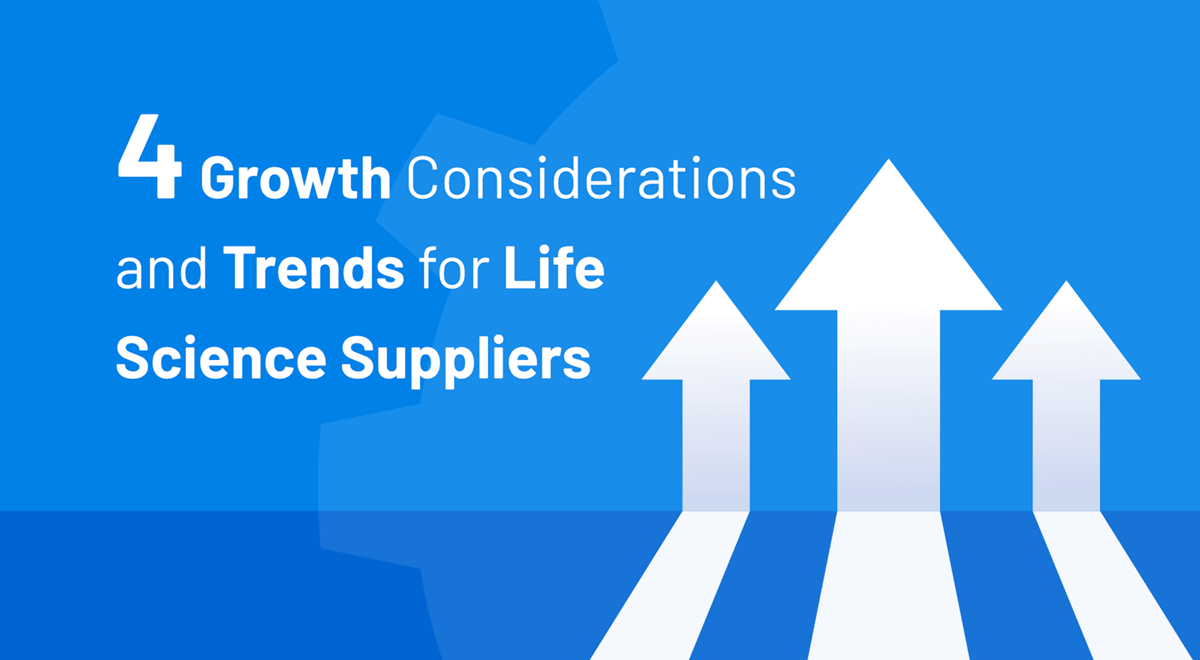Due to a recent surge of public and private funding in response to the COVID-19 pandemic, the life science industry is experiencing a monumental period of growth. Since January 2021, total life science investments have tripled as the demand for biotech R&D has continued to increase.
So, what does such unprecedented growth mean for lab suppliers?
As the industry at large continues to expand, life science lab suppliers are also experiencing rapid growth. The emergence of digital marketplaces has allowed smaller vendors to compete with more established suppliers, transitioning the modern lab supply buying experience into a virtual process for once and for all.
For biotech suppliers intent on continuing to scale in the new year, read on for the top growth considerations for biotech suppliers in 2022 and how the evolution of lab supply purchasing has created more opportunities for niche biotech vendors.
The Evolution of Lab Supply Purchasing
For lab managers and finance teams, ordering lab supplies online is the most streamlined way of finding, ordering, paying for, and tracking the delivery of supplies. However, in the time before digital procurement, ordering supplies looked a little differently.
Contracts were negotiated with each individual vendor at a time, items were selected from a catalog or online ordering system (that likely ran on outdated tech and had limited features like search or saved orders), and invoices were managed manually. For suppliers, fulfilling orders was a time-consuming process and the supposedly simple act of maintaining an updated catalog of supplies amounted to a full-time job.
The creation of e-commerce marketplaces revolutionized digital procurement. With digital procurement processes, lab managers can easily navigate pages of supplies with user-friendly search features, manage relationships with multiple vendors through a single platform, and automate the inventory tracking process.
For suppliers, the digitization of the lab supply purchasing process has meant an ability to foster connections with new leagues of buyers, access to an engaged customer base, and operational cost savings. Ultimately, biotech supply vendors looking to scale their services in the upcoming years benefit from hosting their supplies in a digital marketplace, from a marketing and software development perspective. Marketplaces serve as a built-in partnership, too — they exist in the same industry and space, but don’t serve as a competitor.
Top Growth Considerations for Biotech Suppliers 2022
As R&D innovation needs to continue to expand, the biotech supplier market is racing to keep up with demand. With the global laboratory supplies market size currently projected to reach $54.1 billion by 2028, it’s clear that such demand isn’t dwindling any time soon.
To keep up with the climbing industry demand, here are the top growth considerations for biotech suppliers in the new year.
1. Invest in Digital and Content Marketing
In any industry, investing in digital marketing is a tactic designed to help businesses attract new customers and educate potential buyers on their services. For small and emerging lab supply vendors, investing in digital and content marketing could be what it takes to differentiate yourself in a crowded field — especially one that grows even more crowded with each passing day.
Digital and content marketing strategies for biotech lab suppliers may include:
- Creating a social media presence for your company on the platforms where your audience already exists.
- Running targeted paid ads on popular sites such as Facebook and LinkedIn.
- Optimizing your website so it can easily be searched for and found.
- Publishing resources or blog posts on your website to generate traffic.
- Host virtual events, trade shows, or networking opportunities.
To get started, here is A Guide to Life Science Supplier Marketing.
2. Join an industry-specific marketplace
Digital marketplaces offer life science suppliers an engaged audience and a sophisticated purchasing software, and those with the most impact are the ones that best match your target audience’s needs. Search for an industry-specific marketplace that’s focused on life sciences, biotech, or pharma R&D.
Industry-specific marketplaces provide vendors with increased exposure to their target audience and the opportunity to optimize product descriptions for those in the marketplace.
3. Choose a niche
Before you can join an industry-specific marketplace, vendors must first identify their most successful niche. How would you define the supplies you offer? Do you offer specialized supplies like live organisms or materials that need to be stored at a specific temperature?
Clearly defining your niche allows you to better communicate your service to potential customers. With so many vendors to choose from when procuring supplies, lab managers are looking for any and all signs pointing them to the best vendor for the job.
4. Make sure you have a modern buying experience
Customers now expect seamless ordering, tracking, and communication. As digital marketplaces continue to evolve, the buying experience is evolving with it. To offer your customers the most streamlined, efficient, and user-friendly digital supply purchasing experience, invest in modern eprocurement tech.
For example, marketplace mobile apps are rising in demand as customer desire for flexibility increases. Additionally, AI chatbots are gaining popularity due to their ability to provide 24/7 customer service, with the global chatbot market projected to increase from $17.17 billion in 2020 to over $100 billion by 2026. Providing customers with a modern buying experience allows biotech supply vendors to offer their customers the best service possible and stand out from the outdated competition.
As the world of eprocurement continues to expand, some vendors are struggling to transition alongside the evolving industry. However, one thing has made itself clear, digital marketplaces are the future of lab supply procurement. Learn more about becoming a ZAGENO supplier partner and hosting your products on the ZAGENO biotech marketplace.



